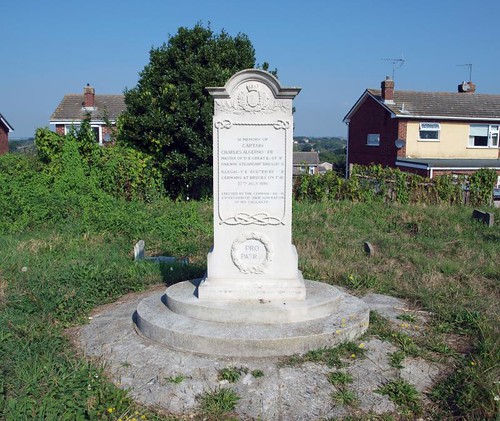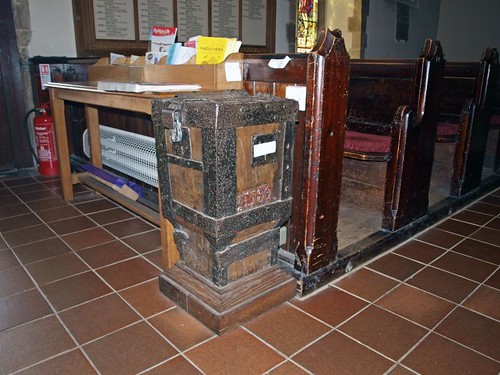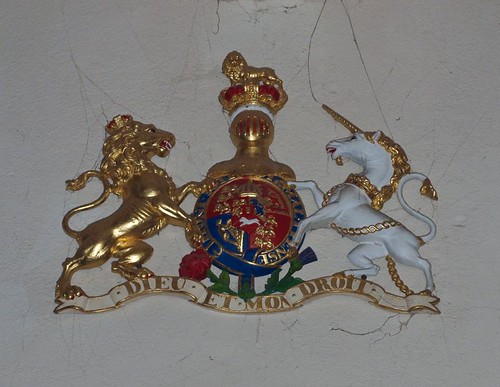ALL SAINTS. Entirely plastered, with pebbledash. Norman nave with one blocked N window visible outside as well as inside. Chancel early C14, see the renewed N and S window. A little more elaborate and slightly later N and S nave windows. The tracery here is flowing. Perp W tower with diagonal buttresses and battlements. - FONT. Octagonal, C14, with cusped panels of tracery (intersected and other), quatrefoils etc. - POOR BOX. Plain, square, iron-bound, dated 1589. 1 BRASS to a Civilian, mid C15; the figure about 2 ft long.
DOVERCOURT. Here in this place, so linked with Harwich and with it transformed into a fortress in the Great War, sleeps one of the bravest heroes of that war, Captain Fryatt. The hub of the peninsula in the early days, it has been swallowed up by Harwich, but has still its wide green and some of its old cottages; 500 yards of breakwater, sea wall, and beautiful undercliff; and a church with two blocked Norman arches surviving in the nave. Most of the windows, the traceried font (once used as a cattle trough), and the doorway are 14th century, and the lower stages of the tower were built about the time of Agincourt. The church has a curiously interesting memorial, for the window in the tower with Our Lord and the Centurion was given to it by the last German Kaiser in memory of many German soldiers who perished with ours in the ill-fated Walcheren expedition of 1810.
There is a 15th century brass of a man in a fur-trimmed gown, a poorbox made while men were still talking of the Armada, a floral cross on a 13th century coffin lid, and a great roodbeam on which stood a crucifix of which a very queer tale is told.
The story is that in the l6th century, before the Reformation, there was an idol called the Rood of Dovercourt which stood at the church door, with such power that no man could shut the door where it stood, so that it was left open for every day and night. It happened that one night three men went from Dedham in the moonlight, took the idol from its shrine, and set it on fire; so great a fire did it make that it “lit up one of the ten miles of their way home.” But within half a year of the burning of the Rood the three men were hanged in chains.
That is as it may be; what moves us here is the grave of Captain Fryatt. When the Great War broke out he was 42, captain of the Great Eastern Railway steamer Brussels, and steamed regularly between England and Holland risking mines and submarines. In March 1915 he shook off a submarine attack and three weeks later he was again assailed, this time passing from defence to attack, steaming straight at his enemy and ramming him. For this gallant feat he was thanked and rewarded by the Admiralty. On his voyage from Holland to Tilbury in 1916 his ship was captured by a German destroyer and Fryatt was taken prisoner. His log was examined and produced in evidence against him at a court martial held at Bruges. Fryatt was under Government orders. He sailed in uniform, and, being attacked, was entitled to resist by force, but his judges held that his conduct was unlawful, that he had no status as a combatant and was no better than a bandit. He was shot that night.
The event aroused deep sorrow and widespread indignation. At the end of the war the Germans reviewed the trial and declared that, while they regretted the haste with which the sentence was executed, the verdict was just and in accordance with their interpretation of the laws of sea Warfare. Fryatt was remembered in honour by his countrymen, and in July 1919 his body was brought home and laid to rest at Dovercourt with full military honours. There is a worthy memorial to him - The Fryatt Memorial Hospital.
Simon K -
I set off from dear, dirty Harwich town up into the prim outer suburbs and then to where it got rough again to find this church open. In fact, the outer doors were latched open back, and it wasn't until I was actually inside the porch that I saw a sign which said We are sorry that the church is not open to the public today because of children's activities. And yes, you could hear them inside, being active.
So, all I could do was to photograph the exterior, and a number of interesting headstones. This is a good medieval church rather done over - the building was encased in cement render in the 1920s, which caused damp to soak into the nave and chancel. Only the top of the red brick tower has been revealed so far in more than twenty years of trying to put it right. It looked a bit battered, and I wondered what the inside was like.
One of the helpers came out for a breath of fresh air, and we got chatting. He confirmed that the church is usually open every day, and that this children's thing was a one-off. But I'm sure they won't mind if you want to take a look inside, he said. Looking down at my camera, I assured him that they would. He agreed reluctantly.
I came back a few Saturdays later. At first I thought the church was locked, because the outer grill was closed and I could see the padlock. But coming closer I saw that it was only on one gate, and so I opened them and then the inner door.
There were three people inside, two of them cleaning, the other one a woman fiddling with paperwork. "Is it possible to take a look around?" I said, and of course yes it was, as it always is. A rather sad interior, shabby but also with a richness of an 18th Century restoration. The east end is delightful. "Of course, Dovercourt was here before Harwich was", said the female cleaner. I think she is probably right, although this directly contradicted what the sitter at Harwich St Nicholas had been keen to impress on me.
A most curious window of the works of mercy is an 1890s near-copy of the 1637 window at Messing I'd seen the previous Saturday. Every window other than this filled with poor quality 1880s glass from a minor workshop, except for two tiny lancets, one with a William Morris figure and the other I think by the York Guild. The great survival here is the medieval rood beam, decorated with vinework in the early 17th Century and inscribed with the date 1615.
It struck me then that you could head west from here, up the Stour
Estuary, along Essex's long border with Suffolk, its border with
Cambridgeshire and then deep into Hertfordshire without finding a
single other locked church. But I didn't say so.
There is a 15th century brass of a man in a fur-trimmed gown, a poorbox made while men were still talking of the Armada, a floral cross on a 13th century coffin lid, and a great roodbeam on which stood a crucifix of which a very queer tale is told.
The story is that in the l6th century, before the Reformation, there was an idol called the Rood of Dovercourt which stood at the church door, with such power that no man could shut the door where it stood, so that it was left open for every day and night. It happened that one night three men went from Dedham in the moonlight, took the idol from its shrine, and set it on fire; so great a fire did it make that it “lit up one of the ten miles of their way home.” But within half a year of the burning of the Rood the three men were hanged in chains.
That is as it may be; what moves us here is the grave of Captain Fryatt. When the Great War broke out he was 42, captain of the Great Eastern Railway steamer Brussels, and steamed regularly between England and Holland risking mines and submarines. In March 1915 he shook off a submarine attack and three weeks later he was again assailed, this time passing from defence to attack, steaming straight at his enemy and ramming him. For this gallant feat he was thanked and rewarded by the Admiralty. On his voyage from Holland to Tilbury in 1916 his ship was captured by a German destroyer and Fryatt was taken prisoner. His log was examined and produced in evidence against him at a court martial held at Bruges. Fryatt was under Government orders. He sailed in uniform, and, being attacked, was entitled to resist by force, but his judges held that his conduct was unlawful, that he had no status as a combatant and was no better than a bandit. He was shot that night.
The event aroused deep sorrow and widespread indignation. At the end of the war the Germans reviewed the trial and declared that, while they regretted the haste with which the sentence was executed, the verdict was just and in accordance with their interpretation of the laws of sea Warfare. Fryatt was remembered in honour by his countrymen, and in July 1919 his body was brought home and laid to rest at Dovercourt with full military honours. There is a worthy memorial to him - The Fryatt Memorial Hospital.
Simon K -
I set off from dear, dirty Harwich town up into the prim outer suburbs and then to where it got rough again to find this church open. In fact, the outer doors were latched open back, and it wasn't until I was actually inside the porch that I saw a sign which said We are sorry that the church is not open to the public today because of children's activities. And yes, you could hear them inside, being active.
So, all I could do was to photograph the exterior, and a number of interesting headstones. This is a good medieval church rather done over - the building was encased in cement render in the 1920s, which caused damp to soak into the nave and chancel. Only the top of the red brick tower has been revealed so far in more than twenty years of trying to put it right. It looked a bit battered, and I wondered what the inside was like.
One of the helpers came out for a breath of fresh air, and we got chatting. He confirmed that the church is usually open every day, and that this children's thing was a one-off. But I'm sure they won't mind if you want to take a look inside, he said. Looking down at my camera, I assured him that they would. He agreed reluctantly.
I came back a few Saturdays later. At first I thought the church was locked, because the outer grill was closed and I could see the padlock. But coming closer I saw that it was only on one gate, and so I opened them and then the inner door.
There were three people inside, two of them cleaning, the other one a woman fiddling with paperwork. "Is it possible to take a look around?" I said, and of course yes it was, as it always is. A rather sad interior, shabby but also with a richness of an 18th Century restoration. The east end is delightful. "Of course, Dovercourt was here before Harwich was", said the female cleaner. I think she is probably right, although this directly contradicted what the sitter at Harwich St Nicholas had been keen to impress on me.
A most curious window of the works of mercy is an 1890s near-copy of the 1637 window at Messing I'd seen the previous Saturday. Every window other than this filled with poor quality 1880s glass from a minor workshop, except for two tiny lancets, one with a William Morris figure and the other I think by the York Guild. The great survival here is the medieval rood beam, decorated with vinework in the early 17th Century and inscribed with the date 1615.
At this point the male cleaner said "I suppose you know you're
lucky to see inside?". It turned out I had been entirely
misinformed. This church is ordinarily kept locked without a
keyholder. "Sadly, that's the way of the world nowadays."
When I pointed out that quite clearly it was not the way of the world
nowadays, given that the vast majority of Essex churches are left open
every day, I was countered with "well, we couldn't possibly leave
it open in a place like Dovercourt".



No comments:
Post a Comment